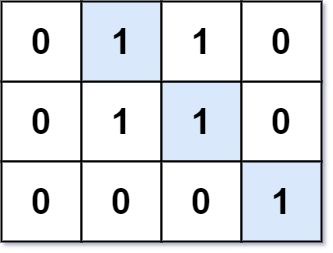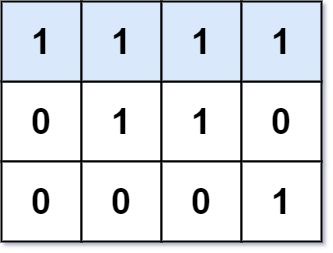Welcome to Subscribe On Youtube
562. Longest Line of Consecutive One in Matrix
Description
Given an m x n binary matrix mat, return the length of the longest line of consecutive one in the matrix.
The line could be horizontal, vertical, diagonal, or anti-diagonal.
Example 1:

Input: mat = [[0,1,1,0],[0,1,1,0],[0,0,0,1]] Output: 3
Example 2:

Input: mat = [[1,1,1,1],[0,1,1,0],[0,0,0,1]] Output: 4
Constraints:
m == mat.lengthn == mat[i].length1 <= m, n <= 1041 <= m * n <= 104mat[i][j]is either0or1.
Solutions
-
class Solution { public int longestLine(int[][] mat) { int m = mat.length, n = mat[0].length; int[][] a = new int[m + 2][n + 2]; int[][] b = new int[m + 2][n + 2]; int[][] c = new int[m + 2][n + 2]; int[][] d = new int[m + 2][n + 2]; int ans = 0; for (int i = 1; i <= m; ++i) { for (int j = 1; j <= n; ++j) { if (mat[i - 1][j - 1] == 1) { a[i][j] = a[i - 1][j] + 1; b[i][j] = b[i][j - 1] + 1; c[i][j] = c[i - 1][j - 1] + 1; d[i][j] = d[i - 1][j + 1] + 1; ans = max(ans, a[i][j], b[i][j], c[i][j], d[i][j]); } } } return ans; } private int max(int... arr) { int ans = 0; for (int v : arr) { ans = Math.max(ans, v); } return ans; } } -
class Solution { public: int longestLine(vector<vector<int>>& mat) { int m = mat.size(), n = mat[0].size(); vector<vector<int>> a(m + 2, vector<int>(n + 2)); vector<vector<int>> b(m + 2, vector<int>(n + 2)); vector<vector<int>> c(m + 2, vector<int>(n + 2)); vector<vector<int>> d(m + 2, vector<int>(n + 2)); int ans = 0; for (int i = 1; i <= m; ++i) { for (int j = 1; j <= n; ++j) { if (mat[i - 1][j - 1]) { a[i][j] = a[i - 1][j] + 1; b[i][j] = b[i][j - 1] + 1; c[i][j] = c[i - 1][j - 1] + 1; d[i][j] = d[i - 1][j + 1] + 1; ans = max(ans, max(a[i][j], max(b[i][j], max(c[i][j], d[i][j])))); } } } return ans; } }; -
class Solution: def longestLine(self, mat: List[List[int]]) -> int: m, n = len(mat), len(mat[0]) a = [[0] * (n + 2) for _ in range(m + 2)] b = [[0] * (n + 2) for _ in range(m + 2)] c = [[0] * (n + 2) for _ in range(m + 2)] d = [[0] * (n + 2) for _ in range(m + 2)] ans = 0 for i in range(1, m + 1): for j in range(1, n + 1): v = mat[i - 1][j - 1] if v: a[i][j] = a[i - 1][j] + 1 b[i][j] = b[i][j - 1] + 1 c[i][j] = c[i - 1][j - 1] + 1 d[i][j] = d[i - 1][j + 1] + 1 ans = max(ans, a[i][j], b[i][j], c[i][j], d[i][j]) return ans -
func longestLine(mat [][]int) (ans int) { m, n := len(mat), len(mat[0]) f := make([][][4]int, m+2) for i := range f { f[i] = make([][4]int, n+2) } for i := 1; i <= m; i++ { for j := 1; j <= n; j++ { if mat[i-1][j-1] == 1 { f[i][j][0] = f[i-1][j][0] + 1 f[i][j][1] = f[i][j-1][1] + 1 f[i][j][2] = f[i-1][j-1][2] + 1 f[i][j][3] = f[i-1][j+1][3] + 1 for _, v := range f[i][j] { if ans < v { ans = v } } } } } return }